#Batman no man’s land
Text
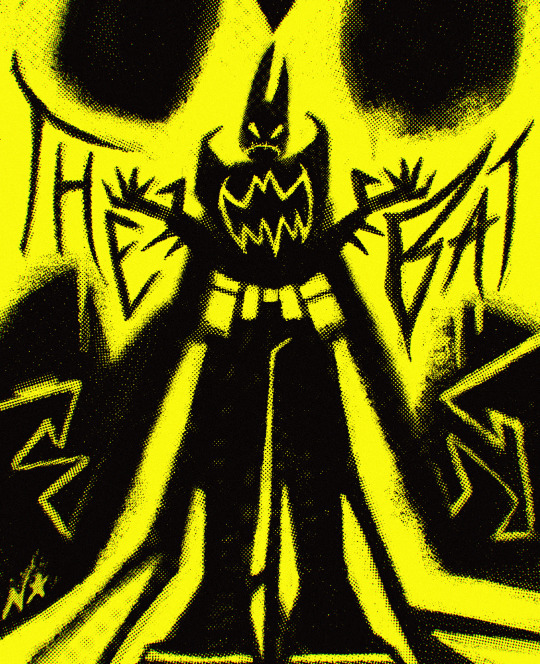
not haunted, infested (helena u will always be a batman to me…)
#helena bertinelli#bart (as in bug art)#the bat#batman#huntress#oooooo u wanna read nml so bad#helena’s there :)#dc#dc comics#batman no man’s land#no man's land
358 notes
·
View notes
Text
Speaking of Cassandra Cain I recently read the No Man’s Land novelization by Rucka
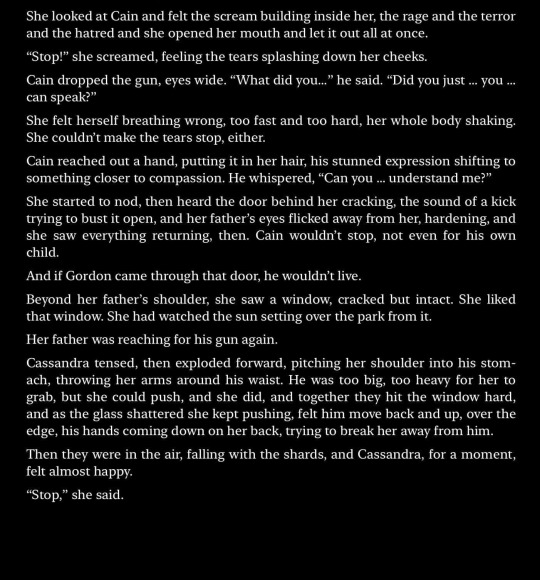
78 notes
·
View notes
Text
I’m reading no man’s land and i am enthralled by this particular hairstyle
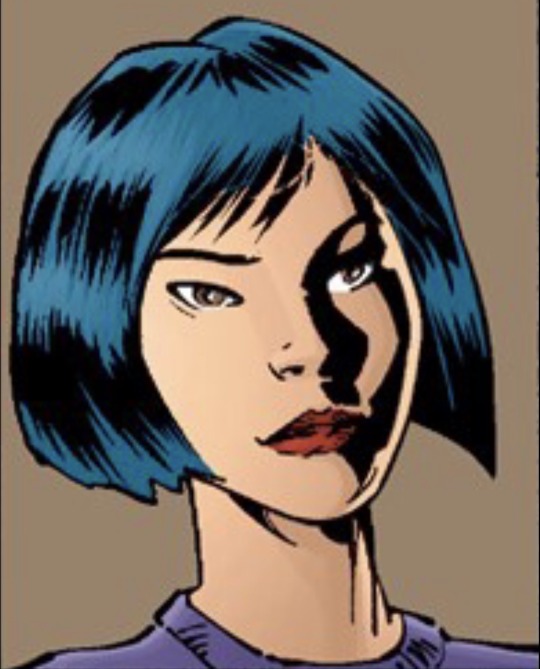
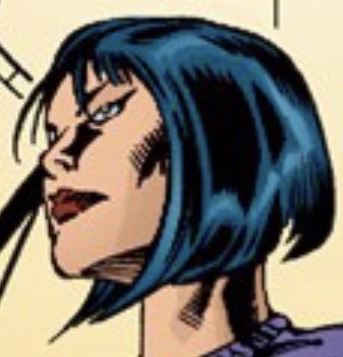
#leo says shit#batfam#cassandra cain#alfred pennyworth#babs gordon#barbara gordon#bruce wayne#dick grayson#tim drake#jean paul valley#Batman no man’s land#jim gordon#renee montoya
140 notes
·
View notes
Text
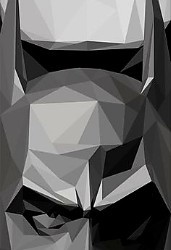
#batman#the dark knight#the batman#dc batman#batman 1989#batman 1966#batman 1940#batman edit#batman eternal#batman comics#batman begins#batman and robin#batman art#batman fandom#batman the dark knight#batman the dark knight returns#batman fanart#batman family#batman forever#batman outlaw#dc comics#dcu#dc#batman movie#batman no man’s land#batman brave and the bold#batman city of madness#batman series#batman dc#bruce wayne
48 notes
·
View notes
Text
currently reading Batman and did he just kidnap a little baby then give the baby back to the mother only if she was in lesbian love with this other woman and held their marriage and put them through the arranged marriage trope even though they were literally just enemies? did that actually just happen??
#Batman healing the world one wlw enemies to lovers arranged marriage at a time#detective comics 733#batman#the batman#detective comics#dc comics#batman no man’s land#bruce wayne#laz.exe#dc
25 notes
·
View notes
Text
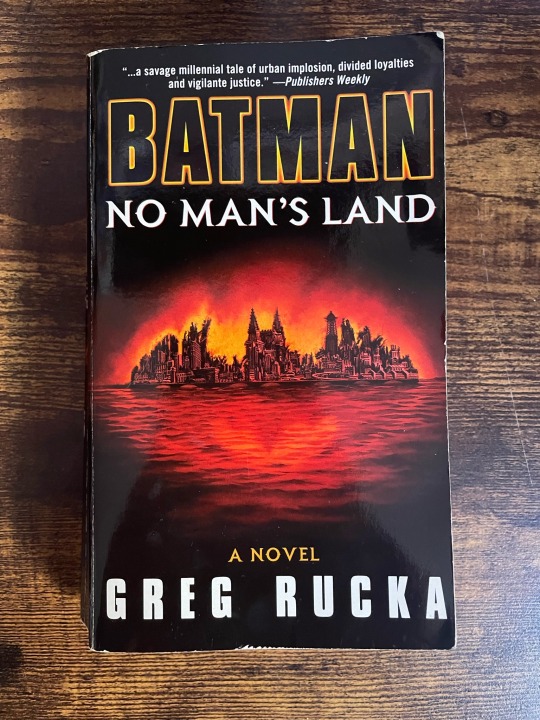
28th December 2023
I’ve been reading a lot of Batman novelizations recently, and I really enjoyed this one!
#nerdy aesthetic#nerdy stuff#aesthetic photography#photography#aesthetic#dc comics#comics#batman#no man’s land#Batman no man’s land#comic book novels
9 notes
·
View notes
Link
Chapters: 1/1
Fandom: Batman - All Media Types, Batman (Comics)
Rating: Not Rated
Warnings: No Archive Warnings Apply
Relationships: Gotham City & Gotham City Residents
Characters: Gotham City, Gotham City Residents
Additional Tags: No Man's Land (DCU), Earthquakes, Natural Disasters, Wordcount: 500-1.000
Series: Part 5 of Annaki's DC work collection
Summary:
7.6 isn’t a large number on most scales of measurement. It is a large number for an earthquake and a rotting city.
#batman#batman cataclysm#batman no man’s land#gotham city#gotham#flash fiction#dc fanfiction#batman fanfiction
3 notes
·
View notes
Text
youtube
Batman Begins: Incorruptible Symbol
#batman begins#batman the dark knight#the dark knight#the dark knight rises#the dark knight returns#christopher nolan#batman the brave and the bold#batman and robin#batman returns#batman#dc joker#dc fanart#dc comics#dc universe#dcu#dc#batman no man’s land#batman ninja#batman beyond#batman brave and the bold#batman bruce wayne#batman bane#batman v superman#batman villains#batman comics#batman music#batman soundtrack#batman zero year#batman year one#batman arkham knight
5 notes
·
View notes
Text
Not So Evergreen: A Perennial Problem
Hi there,
Wouldja believe it, this week I was thinking about comics?
I know, it's hard to imagine I've had time around Valentine's Day and preparing for our impending nuptuals (which you can contribute to if you're so inclined!).
Or around the continued bullshit that is KOSA, which you might've noticed is NOT actually fixed--and still needs to be stopped. Or, as long as we're talking about regulation and the internet and what can/should be regulated to try to make it a better safer place, all the latest "Generative AI" nonsense (not linking anything in particular here, but there're new stupid developments every day).
Or while keeping track of what's happening in Gaza and, specifically, in Rafah, where Palestinians were told to evacuate to and that is now under bombing, or as they continue to attack hospitals and kill civilians. Sharing up top some recent resources I've seen, including a nice list of places where you can donate (you may also notice the PCRF on our registry and thanks to the folks who've already given there) and a nice collection of Palestinian cultural reading and listening and cooking you can do. There continue to be demonstrations and actions--with a lot in the past week being organized to keep hands off Rafah. Call.Fax. Email.Contact the White House. Keep an eye out for actions from organizations like Jewish Voice for Peace, American Muslims for Palestine, BDS, and the Democratic Socialists of America, or whatever local organization is making efforts near you. If spending money brings you any comfort and you feel a need to put something into good practice, the Cartoonist Cooperative's page still lists a ton of resources for E-Sim cards.
But despite the many other things that should and do reasonably take up my time and brainspace--the good and the bad--it is my job to make comics and I do have to spend some time thinking about 'em and something I've been thinking about this week is the strange state of "evergreen titles."
A Perennial Should Standalone
In particular, I was inspired by seeing some random young person somewhere online say a fairly common refrain, something along the lines of "I tried Western superhero comics, couldn't see myself in them, other than one (now) 35-year-old Vertigo series, and found a lot more in manga for me."
This is one of those things I've talked around every part of in the past, I think. I've talked, fairly recently, about how it is strange to me when people cut themselves off from or don't give themselves the opportunity to continue to explore a format or genre of comics entirely as if they're homogenous and how I think that can make you lose out on some of the contextual history of the medium and how storytelling can work within it. I've talked about how manga is just another word for comics and how I think some of the separation of manga and "Western" comics is more artificial than people realize. I've talked about continuity and how it can be a real turn-off for people, but also how even when it does matter, it maybe kinda doesn't matter, and even earlier than that, I talked about how they say every comic is somebody's first comic and the strange balance of serialized storytelling and accessibility. And just last week, I was mentioning how I think N.K. Jemisen's Far Sector is a really great example of a modern "here's how cool superhero comics can be" book. Now I want to pull it all together and talk about how we've maybe canonized a lot of comics that require a higher bar of context than they're often given.
Now, last bit of business before we dive in, just in case, what do I mean when I say perennial or evergreen title? They are a little different, though I'm largely using them interchangably here. There are certain comics that have been canonized (not meaning made canon to a in-universe continuity, but the older definition of added to the historical register as a work of significance) that you can pretty much always find, and that has grown even more with the increased importance of the book market to comics sales. To use a very important example, you can walk into *most* any comic shop or bookstore that carries comics and is not specifically a specialty shop (like not Silver Sprocket probably, but also, shout out to them for joining the PACBI) and find a copy of Watchmen. Doesn't matter that the book is nearly 40 years old, it has been kept in print constantly (which... if you aren't familiar, is a story unto itself) and y'know, still sells. New people discover/buy/upgrade their copies of Watchmen every year and DC always points to it as an Essential title in their annual catalogs.
DC in particular is actually pretty good about promoting their evergreens. They release an annual catalog to comic shops (and some book stores) that's like a free 80-ish page thing about like "if you want to read DC comics, here are titles we recommend." And if you're even halfway immersed in American Superhero Comics, you could probably name a good half-dozen of them off the top of your head. Watchmen! The Killing Joke! Sandman! All-Star Superman! Batman: The Long Halloween! Batman: Hush! Arkham Asylum: A Serious House on Serious Earth! Kingdom Come! Dark Knight Returns! Other titles written 30-40 years ago by a White British person! Any title from the past 7 years written by a guy named Tom! Etc! I'm being a little flip, and generally, like a lot of those books, but it's true, those tend to be what gets platformed in that way. And, credit where it's due, I know the last catalog also included things like Far Sector and Wonder Woman Historia and Nubia: Real One and the Kami Garcia/Gabriel Picolo Teen Titans OGNs.
But what I find complicated about a lot of those decisions is that a lot of those books may be self-contained in that you can read a single volume or single series and get a pretty complete story without a lot of continuity fluff or cross-reading or whatever, but I think a lot of those books benefit from having existing grounding in reading superhero comics that can get lost when they're being presented not only outside the context of what they were originally in conversation with, but as books of high accessibility or jumping on points.
I could probably go on about most of these, but I'm going to use Killing Joke as an example because it's a really clear one. It's famously a "read this book" kinda book. I think it's still in the DC 25 Essential titles list. It's also a book that is STEEPED in important context that it usually isn't presented with and that I think does really change the reading experience.
Like, when Killing Joke was originally released, it was part of a big push of the Joker at DC. In early 1988, Killing Joke comes out, followed a few months later by A Death in the Family (the one where he killed Jason Todd Robin) and the year capped off with a Greatest Joker Stories Ever Told collection that didn't include either of those stories because, y'know, they were both too new. And modern collections (the 75th and 80th, respectively) both include, interestingly, 1 issue each of A Death in the Family (and different ones at that) and only an excerpt of Killing Joke because they usually don't like to collect it because it can take up a lot of pages for a book that most people own as an individual volume (though... interestingly, the 80th does include Mad Love). Sorry, getting a little distracted. But you know what the Greatest Joker Stories does include? A comic from 1966 that came in a box of PopTarts. Pre-'88, he had gone through cycles of being serious, silly (not even connected to Batman '66, the Joker's many boners story was from the early '50s!), and serious again when he returned in the '70s, but it was never to the extent that Killing Joke went to and that was solidified by the next year of publishing. And, even then, the next year brought some very different Jokers: Jack Nicholson's live-action version who is very much not the Killing Joke Joker and the Joker of Arkham Asylum, who again, is also violent, but in a very different way.
As you start looking at the long-tail, you see the Killing Joke interpretation more in the Batman: The Animated Series version of the character (though, obviously, toned down somewhat for the audience) and that continues to resonate through each version of Joker that happens after across media (except maybe Batman: The Brave and the Bold, because that series is so Silver Age-y). You get Oracle going from a somewhat unexpected character in Suicide Squad to being a major part of the Bat-family and really evolving as a character as Birds of Prey took flight in the late '90s (pin in that for a sec). There are stories that directly reference it, like that Booster Gold issue where he keeps trying (and failing) to change the past because Rip Hunter (almost wrote Rip Torn, who would've made for a very different Booster Gold book) lied to him. There are whole projects that are inspired by it, like the One Bad Day books from 2022/23. There are real world effects, like the things I mentioned earlier with it becoming an evergreen title and one of the first big DC tentpoles to have as a constant at comic shops and in bookstores (especially as the book market has become increasingly important).
Looking at the sort of joint in continuity and publishing history leading up to Killing Joke, it's important to know that Joker and Barbara Gordon had been sort of in-and-out of the comics. Joker hadn't had a major break in a while--also an influential factor on Killing Joke, another darker '80s Joker was in Dark Knight Returns just a couple years prior. But he had been a character who kinda disappeared out of the comics in the past--I think before his return in Batman #251 in '71, he had not been in a comic in like 4 years. And, speaking of not being in comics in 4 years, Barbara Gordon had largely retired as Batgirl before Crisis on Infinite Earths in '85 and was basically a non-character in DC comics post Crisis until Killing Joke. It's part of why the story got approved with her in it and part of why she got taken over to Suicide Squad afterwards... there weren't any plans for Batgirl otherwise.
And all of that is before we're even talking about stuff like the fact that it was recolored and the recoloring really changes the reading experience (TBH, I am not a fan) or that it's a book that if you are recommending it to someone, you should tell them that it's a book with a heavy trigger warning for sexual assault. It's not talking about it as an Alan Moore project and his publicly bad relationship with DC/Warner (see, among other things, that earlier Watchmen article).
So many of these books have that sort of important contextual elements that change the way they're read. I think it's important to know that Sandman is a DC universe book and at least something about some of the DC characters who get featured (like Prez, Element Woman, and Dr. Destiny). All-Star Superman is in conversation with Superman comics of the Golden and Silver age and I think in particular dialogue with Whatever Happened to the Man of Tomorrow (and, hey, again, probably helpful to know that Grant and Alan have their issues).
How to Contextualize, Or Find New Evergreens
Okay, brief note: Becca and I went and saw Madame Web and this was left unfinished when we did. Madame Web was great. It was genuinely bad. It was the Cats (2019) of superhero movies. I've never seen a movie where literally all the content was in the trailer and the rest of the movie was deleted scenes. Anyway, after it was over, we went to the Barnes & Noble next to the theater and listened to this couple talking in the comics section and literally every book they gravitated to was one of these sorts of evergreen titles--Sandman was mentioned, Watchmen and Before Watchmen, V for Vendetta, etc. It was clear they weren't really readers, they seemed to be shopping for someone else, but that their primary frame of reference was TV shows and movies, which also goes to the whole "what makes it evergreen" argument and is really interesting because through adaptation, some of the importance of how these things work in the comics medium is lost. And by the end of it... I think they just didn't pick up a comic. Anyway, was just kinda funny to have a real world example of this exact phenomenon I'm talking about happen mid-blog.
Only other thing I want to say before getting any further. Obviously, I've focused a lot on DC titles. The reason is DC makes it easy. Like I said, they literally put out a catalog with their "here's what we think is most essential from our library" every year. DC's also got a long track record of these types of titles to examine and particularly because the initial comment led me to think it was more about American Superhero Comics, it was a clear focus. Every comic company does have their evergreen titles and I think evergreens are a good thing! When positioned properly, they are supposed to be new reader friendly and a great way to get into the medium. I'll talk a bit about Marvel in this section, but I'd also like to acknowledge that one really smart move that Image made (not entirely sure if they're still doing this, but props where it's due) is they made the first volume of multi-volume series--particularly the ones that seemed ripe for perennial status like Saga--$10. I think making these titles at an accessible price point is a good way to help prop up the things that can help secure a love of the medium and drive further visits to comic shops and bookstores.
More generally, I think there are two things that would both be rad if they were to happen because I think they'd be really helpful for onboarding new readers. The first is I wish there were more international approaches that were like the partworks collections. If you're unfamiliar, there've been a few of them from the UK, including Marvel, DC (who started with Eaglemoss and actually got picked up by Hachette later on), Transformers, Star Trek, and Judge Dredd, wherein significant arcs were released periodically with connecting spine art so they looked really nice together on a shelf that featured additional material like introductions and contextual writings on the reason the arc is significant and the featured character(s) and the creators and really provided at least a starting point of context. The other kinda interesting thing is for the Hachette ones at least, they were released with two numbering systems: one by release of the partworks collection, one by (relative) release order of the original story relative to the other partworks releases. It's almost like when you used to buy an encyclopedia set and every however often the new volume would be ready and you'd have to buy that. I think that's a really cool approach to bringing comics backlist to new and lapsed readers and particularly with the contextualization element, gives you reason to understand why these stories are evergreen. It's exciting to look at partworks as almost a curated greatest hits collection.
The other thing, and again, I think this is already in progress with both what DC is doing generally with their Essentials catalog and specifically with a lot of the stuff in their middle grade and young adult OGN space (and to a lesser extent with Black Label) and with the more recent additions to the Hachette Partworks--is I think that the "canonical" books need to be updated. And, of course, I have a lot of thoughts on what should be on those lists. I've said it before, but Far Sector would certainly be on my list. As would Superman Smashes the Klan. Just to throw out a couple of others: Hawkeye: My Life as a Weapon, Batman: No Man's Land, Young Justice: Sins of Youth, New Frontier, GL/GA: Hard Travelin' Heroes, (when it's collected, the first arc of the current Birds of Prey series), no longer a big two series, but Astro City (honestly... any volume), Spider-Man: Kraven's Last Hunt, X-Men: Dark Phoenix Saga, Marvels, Shadow of the Batgirl, Wednesday Comics, Gen13: Meanwhile (hey, that collection slaps), Mr. Majestic (the '99 run), Starman: Hell and Back, uhh... can we just collect all the pages where the Legion of Superheroes wore outfits designed by kids and fans, and probably a lot of other dumb stuff. But besides being the books that I really like and feel like are deserving of a place in more readers minds, I think the important thing is that we expand from books that may've had a splash outside the medium's traditional haunts (be that in films & TV or literary circles) or that we as comics people recognize for their artistic merit or internal cultural significance to books that celebrate and capture how fun comics can be! Also... and I realize what my own list looks like as I say this, but... fewer comics by white guys, please.
And now, our regular features.
New Releases this week (2/14/24):
None
New Releases next week (2/21/24):
Godzilla Rivals: Mothra vs. MOGUERA (Editor - IDW, post-leaving)
Announcements:
Happy Black History Month! This week, I want to spotlight writer/editor Joseph Illidge! He's one of those guys who has been everywhere--Milestone/DC, Valiant, Heavy Metal, Lion Forge, etc. He's got irons in a few fires right now, from Noir is the New Black to teasing a new Image project coming to doing more editorial work to doing some pretty good articles of his own on the current and historical state of the comics biz. Among his many editorial credits is one of the books I mentioned feeling like should be treated more as an evergreen title (though... given it's complexity and just how many titles it ran through, I do understand that it's a bit harder): Batman: No Man's Land. But he's on all the socials and always has something cool brewing, so throw him a follow!
Sorry that Patreon is still behind! I've sent in a help request and once it's all sorted, blogs will be going back up regularly! As mentioned above, we're getting ready for wedding and travel and expenses around all that, so please also check out my webstore, my Kofi, my eBay, and Becca's site for additional ways to support us and get a little something for yourself!
What I enjoyed this week:
Nancy (Comic), Yu-Gi-Oh: Duel Links (Video Game), Baldur's Gate III (Video Game), Blank Check (Podcast), Solve This Murder (Podcast), The City We Became (Book), Blade Runner 2049 (Movie), Madame Web (Movie), Witch Watch (Manga), One Piece (Manga), Dandadan (Manga), Lore Olympus (Webcomic), Death to Smoochy (Movie), Dungeons & Daddies (Podcast), and big thanks to everyone who has already given us a little something for the wedding!
Pic of the Week:
Nadja made a new friend (?) and his name is Optimus Prime. But she HATES that Sonic.
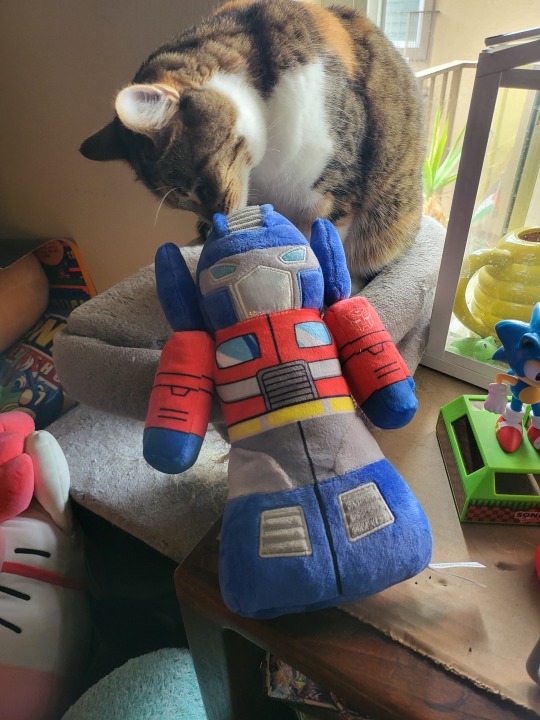
#comics#stop kosa#free palestine#hands off rafah#eyes on rafah#batman no man’s land#killing joke#canonical comics#far sector#a lot of dc comics sorry#comic opinions#a cat that loves optimus and hates sonic
2 notes
·
View notes
Text
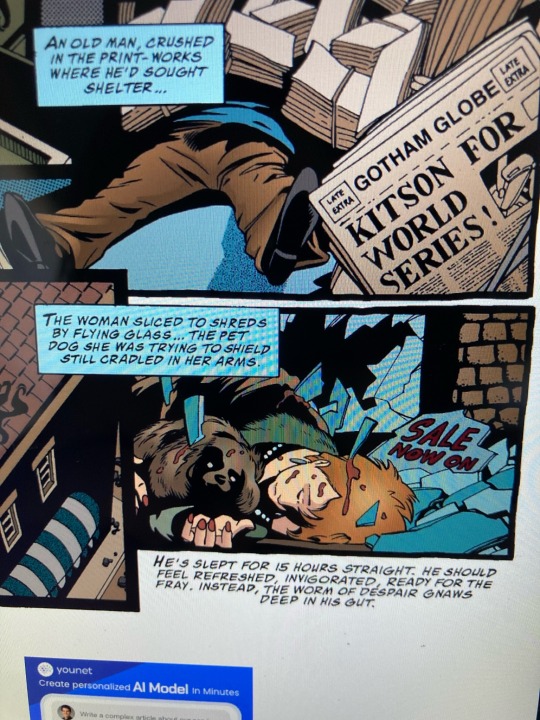
Man I’m gonna start bawling over this
2 notes
·
View notes
Text
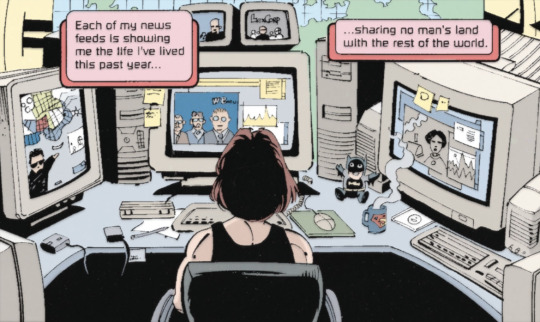
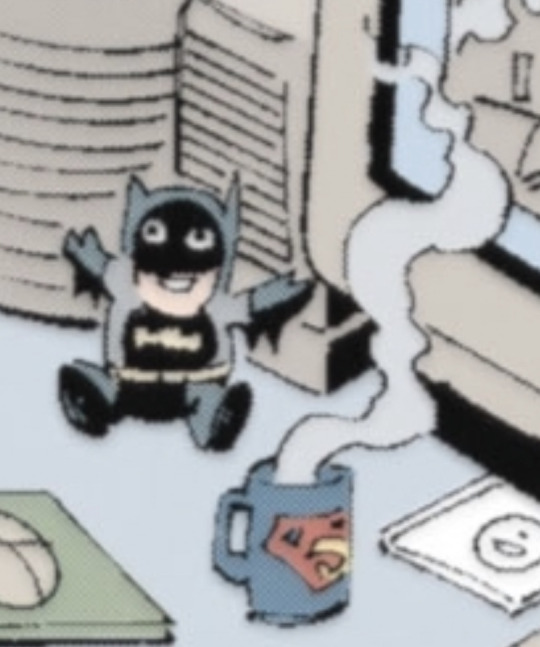
Obsessed with Babs’ desk trinkets
8 notes
·
View notes
Text

from Batman #568 (1999)
By Greg Rucka and Dan Jurgens, coloured by Noelle Giddings
#loved the colours in this storyline#really desaturated the blues and greens and Meade the reds bright#*made#esp for a story with poison ivy#Tim drake#dc#batman#robin#on another page he screams bomb voyage#Batman no man’s land#Batman fruit of the earth#comic panels
16 notes
·
View notes
Text
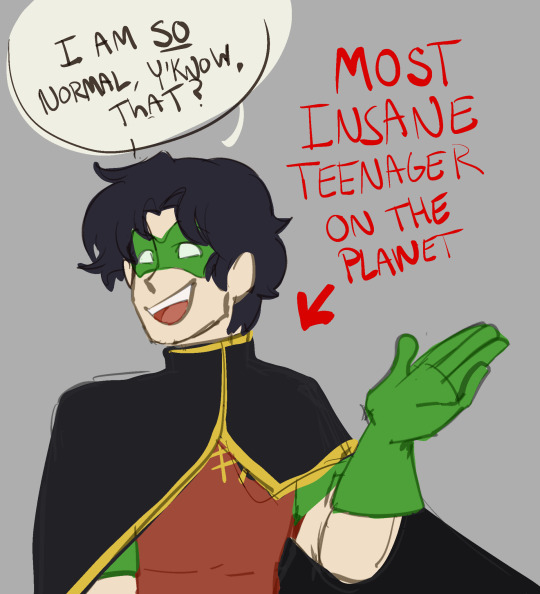
Robin(1993) is a comic where things happen
#the 90’s and early 00’s were a wonderful awful time#seriously like tim’s robin years are insane#man lost his mom got a step mom went to 8 schools dated like 3 girls had all his friends die#had his dad threaten batman with a gun poisoned lady shiva his dad died#he made up an uncle!!!#went to fucking boarding school#SNUCK INTO NO MANS LAND#survived an ebola epicemic#helped form a super hero team#it just keeps going#dc#tim drake#robin#spork art#1k#5k
6K notes
·
View notes
Text
Azrael’s so powerful and awesome dc knew they had to gatekeep him behind the most annoying text possible
6 notes
·
View notes
Text
anyways it is important that steph grew up in the suburbs. it is important to her story as an outsider of not just the batfam but gotham city itself. her relative isolation in the suburbs means something.
similarly, tim's childhood spent in flux & boarding schools, but his home base being gotham city itself (through his parents' various apartments throughout the city) is also important to his story. gotham city is the epicenter of security for him. he may have to leave sometimes, but it is the place where he returns home, where he has any semblance of 'this is home' (until they move out to bristol ofc, and that becomes home). he grew up in the city, many different parts of it. that's important!!
#anytime i read something that says steph grew up in the city and tim in the suburbs-#jack's reluctance to move out of the bustle of the city out to the outskirts in bristol my beloved#batman 480 & batman 481 my beloveds#there is also an interesting interconnectedness between bristol & gotham city#that doesn't exist between other suburbs of gotham & gotham also means something 2 me#steph wasn't touched by contagion#she was sent to a shelter also in the suburbs during cataclysm#during no man's land she was firmly outside of gotham the entire time#the circles are circling
226 notes
·
View notes
Text
reading Batman cataclysm and why is Tim such a jumpscare oh my GOD 😭
#ITS SO UNEXPECTING EVERY TIME#tim drake#bruce wayne#batman#Batman cataclysm#Batman no man’s land#laz.exe#dc
25 notes
·
View notes